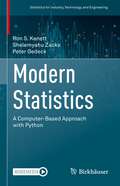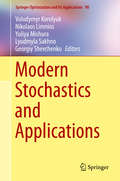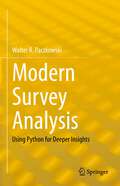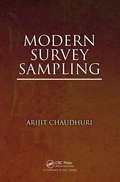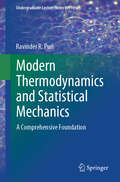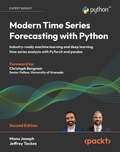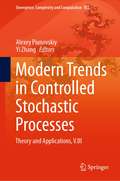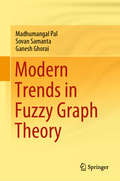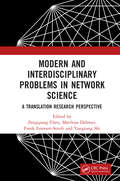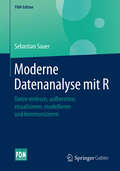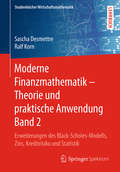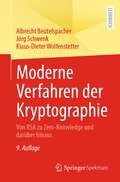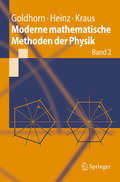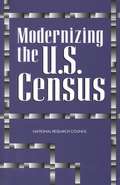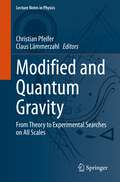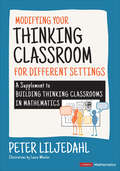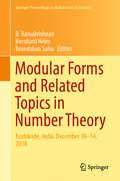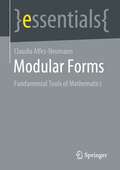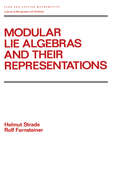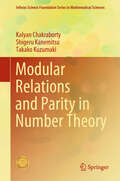- Table View
- List View
Modern Statistics: A Computer-Based Approach with Python (Statistics for Industry, Technology, and Engineering)
by Shelemyahu Zacks Ron S. Kenett Peter GedeckThis innovative textbook presents material for a course on modern statistics that incorporates Python as a pedagogical and practical resource. Drawing on many years of teaching and conducting research in various applied and industrial settings, the authors have carefully tailored the text to provide an ideal balance of theory and practical applications. Numerous examples and case studies are incorporated throughout, and comprehensive Python applications are illustrated in detail. A custom Python package is available for download, allowing students to reproduce these examples and explore others.The first chapters of the text focus on analyzing variability, probability models, and distribution functions. Next, the authors introduce statistical inference and bootstrapping, and variability in several dimensions and regression models. The text then goes on to cover sampling for estimation of finite population quantities and time series analysis and prediction, concluding with two chapters on modern data analytic methods. Each chapter includes exercises, data sets, and applications to supplement learning.Modern Statistics: A Computer-Based Approach with Python is intended for a one- or two-semester advanced undergraduate or graduate course. Because of the foundational nature of the text, it can be combined with any program requiring data analysis in its curriculum, such as courses on data science, industrial statistics, physical and social sciences, and engineering. Researchers, practitioners, and data scientists will also find it to be a useful resource with the numerous applications and case studies that are included. A second, closely related textbook is titled Industrial Statistics: A Computer-Based Approach with Python. It covers topics such as statistical process control, including multivariate methods, the design of experiments, including computer experiments and reliability methods, including Bayesian reliability. These texts can be used independently or for consecutive courses.The mistat Python package can be accessed at https://gedeck.github.io/mistat-code-solutions/ModernStatistics/"In this book on Modern Statistics, the last two chapters on modern analytic methods contain what is very popular at the moment, especially in Machine Learning, such as classifiers, clustering methods and text analytics. But I also appreciate the previous chapters since I believe that people using machine learning methods should be aware that they rely heavily on statistical ones. I very much appreciate the many worked out cases, based on the longstanding experience of the authors. They are very useful to better understand, and then apply, the methods presented in the book. The use of Python corresponds to the best programming experience nowadays. For all these reasons, I think the book has also a brilliant and impactful future and I commend the authors for that."Professor Fabrizio RuggeriResearch Director at the National Research Council, ItalyPresident of the International Society for Business and Industrial Statistics (ISBIS)Editor-in-Chief of Applied Stochastic Models in Business and Industry (ASMBI)
Modern Stochastics and Applications
by Yuliya Mishura Nikolaos Limnios Volodymyr Korolyuk Lyudmyla Sakhno Georgiy ShevchenkoThis volume presents an extensive overview of all major modern trends in applications of probability and stochastic analysis. It will be a great source of inspiration for designing new algorithms, modeling procedures and experiments. Accessible to researchers, practitioners, as well as graduate and postgraduate students, this volume presents a variety of new tools, ideas and methodologies in the fields of optimization, physics, finance, probability, hydrodynamics, reliability, decision making, mathematical finance, mathematical physics and economics. Contributions to this Work include those of selected speakers from the international conference entitled "Modern Stochastics: Theory and Applications III," held on September 10 -14, 2012 at Taras Shevchenko National University of Kyiv, Ukraine. The conference covered the following areas of research in probability theory and its applications: stochastic analysis, stochastic processes and fields, random matrices, optimization methods in probability, stochastic models of evolution systems, financial mathematics, risk processes and actuarial mathematics and information security.
Modern Survey Analysis: Using Python for Deeper Insights
by Walter R. PaczkowskiThis book develops survey data analysis tools in Python, to create and analyze cross-tab tables and data visuals, weight data, perform hypothesis tests, and handle special survey questions such as Check-all-that-Apply. In addition, the basics of Bayesian data analysis and its Python implementation are presented. Since surveys are widely used as the primary method to collect data, and ultimately information, on attitudes, interests, and opinions of customers and constituents, these tools are vital for private or public sector policy decisions.As a compact volume, this book uses case studies to illustrate methods of analysis essential for those who work with survey data in either sector. It focuses on two overarching objectives:Demonstrate how to extract actionable, insightful, and useful information from survey data; andIntroduce Python and Pandas for analyzing survey data.
Modern Survey Sampling
by Arijit ChaudhuriStarting from the preliminaries and ending with live examples, Modern Survey Sampling details what a sample can communicate about an unknowable aggregate in a real situation. The author lucidly develops and presents numerous approaches. He details recent developments and explores fresh and unseen problems, hitting upon possible solutions. The text covers current research output in a student-friendly manner with attractive illustrations. It introduces sampling and discusses how to select a sample for which a selection-probability is specified to prescribe its performance characteristics. The author then explains how to examine samples with varying probabilities to derive profits. He then examines how to use partial segments to make reasonable guesses about a sample's behavior and assess the elements of discrepancies. Including case studies, exercises, and solutions, the book highlights special survey techniques needed to capture trustworthy data and put it to intelligent use. It then discusses the model-assisted approach and network sampling, before moving on to speculating about random processes. The author draws on his extensive teaching experience to create a textbook that gives your students a thorough grounding in the technologies of survey sampling and modeling and also provides you with the tools to teach them.
Modern Survival Analysis in Clinical Research: Cox Regressions Versus Accelerated Failure Time Models
by Aeilko H. Zwinderman Ton J. CleophasAn important novel menu for Survival Analysis entitled Accelerated Failure Time (AFT) models has been published by IBM (international Businesss Machines) in its SPSS statistical software update of 2023. Unlike the traditional Cox regressions that work with hazards, which are the ratio of deaths and non-deaths in a sample, it works with risk of death, which is the proportion of deaths in the same sample. The latter approach may provide better sensitivity of testing, but has been seldom applied, because with computers risks are tricky and hazards because they are odds are fine. This was underscored in 1997 by Keiding and colleague statisticians from Copenhagen University who showed better-sensitive goodness of fit and null-hypothesis tests with AFT than with Cox survival tests.So far, a controlled study of a representative sample of clinical Kaplan Meier assessments, where the sensitivity of Cox regression is systematically tested against that of AFT modeling, has not been accomplished. This edition is the first textbook and tutorial of AFT modeling both for medical and healthcare students and for professionals. Each chapter can be studied as a standalone, and, using, real as well as hypothesized data, it tests the performance of the novel methodology against traditional Cox regressions. Step by step analyses of over 20 data files stored at Supplementary Files at Springer Interlink are included for self-assessment. We should add that the authors are well qualified in their field. Professor Zwinderman is past-president of the International Society of Biostatistics (2012-2015) and Professor Cleophas is past-president of the American College of Angiology (2000-2002). From their expertise they should be able to make adequate selections of modern data analysis methods for the benefit of physicians, students, and investigators. The authors have been working and publishing together for 25 years and their research can be characterized as a continued effort to demonstrate that clinical data analysis is not mathematics but rather a discipline at the interface of biology and mathematics.
Modern Thermodynamics and Statistical Mechanics: A Comprehensive Foundation (Undergraduate Lecture Notes in Physics)
by Ravinder R. PuriThis undergraduate-level textbook offers a unique and in-depth approach to the study of thermodynamics and statistical mechanics. It covers the fundamentals of thermodynamics using both traditional and postulatory approaches, including origin of the concept of thermodynamic entropy, Euler’s equation, Gibbs-Duhem relations, stability of equilibrium, and the concept of thermodynamic potentials, and that of independent thermodynamic observables. The book then delves into the microscopic foundation of thermodynamics, starting with the kinetic theory and highlighting its historical development. Boltzmann's concept of entropy is explored, along with its applications in deriving Planck’s, Bose’s, Bose-Einstein, and Fermi-Dirac distribution functions. The formal structure of classical and quantum statistical mechanics is built based on the concept of statistical entropy and the maximum entropy principle and used to investigate in detail the thermodynamic properties of ideal classical and quantum systems. The book also covers phase transitions, simple theory of critical phenomena, and the theory of interacting van der Waals gases. Throughout the text, the book provides historical context, enriching the reader's understanding. This textbook is a valuable resource for undergraduate physics students, offering comprehensive coverage, including overlooked topics, and a historical perspective on thermodynamics and statistical mechanics.
Modern Time Series Forecasting with Python: Industry-ready machine learning and deep learning time series analysis with PyTorch and pandas
by Manu Joseph Jeffrey TackesLearn traditional and cutting-edge machine learning (ML) and deep learning techniques and best practices for time series forecasting, including global forecasting models, conformal prediction, and transformer architecturesKey FeaturesApply ML and global models to improve forecasting accuracy through practical examplesEnhance your time series toolkit by using deep learning models, including RNNs, transformers, and N-BEATSLearn probabilistic forecasting with conformal prediction, Monte Carlo dropout, and quantile regressionsPurchase of the print or Kindle book includes a free eBook in PDF formatBook DescriptionPredicting the future, whether it's market trends, energy demand, or website traffic, has never been more crucial. This practical, hands-on guide empowers you to build and deploy powerful time series forecasting models. Whether you’re working with traditional statistical methods or cutting-edge deep learning architectures, this book provides structured learning and best practices for both. Starting with the basics, this data science book introduces fundamental time series concepts, such as ARIMA and exponential smoothing, before gradually progressing to advanced topics, such as machine learning for time series, deep neural networks, and transformers. As part of your fundamentals training, you’ll learn preprocessing, feature engineering, and model evaluation. As you progress, you’ll also explore global forecasting models, ensemble methods, and probabilistic forecasting techniques. This new edition goes deeper into transformer architectures and probabilistic forecasting, including new content on the latest time series models, conformal prediction, and hierarchical forecasting. Whether you seek advanced deep learning insights or specialized architecture implementations, this edition provides practical strategies and new content to elevate your forecasting skills.What you will learnBuild machine learning models for regression-based time series forecastingApply powerful feature engineering techniques to enhance prediction accuracyTackle common challenges like non-stationarity and seasonalityCombine multiple forecasts using ensembling and stacking for superior resultsExplore cutting-edge advancements in probabilistic forecasting and handle intermittent or sparse time seriesEvaluate and validate your forecasts using best practices and statistical metricsWho this book is forThis book is ideal for data scientists, financial analysts, quantitative analysts, machine learning engineers, and researchers who need to model time-dependent data across industries, such as finance, energy, meteorology, risk analysis, and retail. Whether you are a professional looking to apply cutting-edge models to real-world problems or a student aiming to build a strong foundation in time series analysis and forecasting, this book will provide the tools and techniques you need. Familiarity with Python and basic machine learning concepts is recommended.
Modern Trends in Controlled Stochastic Processes: Theory and Applications, V.III (Emergence, Complexity and Computation #41)
by Yi Zhang Alexey PiunovskiyThis book presents state-of-the-art solution methods and applications of stochastic optimal control. It is a collection of extended papers discussed at the traditional Liverpool workshop on controlled stochastic processes with participants from both the east and the west. New problems are formulated, and progresses of ongoing research are reported. Topics covered in this book include theoretical results and numerical methods for Markov and semi-Markov decision processes, optimal stopping of Markov processes, stochastic games, problems with partial information, optimal filtering, robust control, Q-learning, and self-organizing algorithms. Real-life case studies and applications, e.g., queueing systems, forest management, control of water resources, marketing science, and healthcare, are presented. Scientific researchers and postgraduate students interested in stochastic optimal control,- as well as practitioners will find this book appealing and a valuable reference.
Modern Trends in Fuzzy Graph Theory
by Madhumangal Pal Sovan Samanta Ganesh GhoraiThis book provides an extensive set of tools for applying fuzzy mathematics and graph theory to real-life problems. Balancing the basics and latest developments in fuzzy graph theory, this book starts with existing fundamental theories such as connectivity, isomorphism, products of fuzzy graphs, and different types of paths and arcs in fuzzy graphs to focus on advanced concepts such as planarity in fuzzy graphs, fuzzy competition graphs, fuzzy threshold graphs, fuzzy tolerance graphs, fuzzy trees, coloring in fuzzy graphs, bipolar fuzzy graphs, intuitionistic fuzzy graphs, m-polar fuzzy graphs, applications of fuzzy graphs, and more. Each chapter includes a number of key representative applications of the discussed concept. An authoritative, self-contained, and inspiring read on the theory and modern applications of fuzzy graphs, this book is of value to advanced undergraduate and graduate students of mathematics, engineering, and computer science, as well as researchers interested in new developments in fuzzy logic and applied mathematics.
Modern and Interdisciplinary Problems in Network Science: A Translational Research Perspective
by Zengqiang Chen, Matthias Dehmer, Frank Emmert-Streib and Yongtang ShiModern and Interdisciplinary Problems in Network Science: A Translational Research Perspective covers a broad range of concepts and methods, with a strong emphasis on interdisciplinarity. The topics range from analyzing mathematical properties of network-based methods to applying them to application areas. By covering this broad range of topics, the book aims to fill a gap in the contemporary literature in disciplines such as physics, applied mathematics and information sciences.
Modern's ABC of Mathematics class 10 - Meghalaya Board
by J. P. Mohindru Bharat MohindruTextbook for Mathematics specially created for Meghalaya Board of School Education for the students of class 10.
Moderne Datenanalyse mit R: Daten einlesen, aufbereiten, visualisieren, modellieren und kommunizieren (FOM-Edition)
by Sebastian SauerDie Kaufempfehlung, die Ihnen ein Webstore ausspricht, die Einschätzung, welcher Kunde kreditwürdig ist, oder die Analyse der Werttreiber von Immobilien – alle diese Beispiele aus dem heutigen Leben sind Ergebnis moderner Verfahren der Datenanalyse. Dieses Buch führt in solche statistische Verfahren anhand der Programmiersprache R ein. Ziel ist es, Leser mit der Art und Weise vertraut zu machen, wie führende Organisationen und Praktiker angewandte Statistik heute einsetzen. Weil sich mit der Digitalisierung auch die statistischen Verfahren verändert haben, vermittelt der Autor neben klassischen Analysemethoden wie Regression auch moderne Methoden wie Textmining und Random-Forest-Modelle. Dabei sind die Inhalte des Buchs durchgehend so aufbereitet, dass sie auch für Leser ohne umfangreiche mathematische Vorkenntnisse verständlich sind. Anhand von Fallbeispielen und Übungen werden die Leser durch alle Phasen der Datenanalyse geführt: Sie lernen, wie Daten eingelesen, aufbereitet, visualisiert, modelliert und kommuniziert werden können. Dabei wird vor allem die Aufbereitung, Umformung und Prüfung der Daten ausführlicher als in anderen Publikationen behandelt, da dieser Teil in der Praxis oft einen wesentlichen Teil des Aufwands ausmacht. Aber auch die Visualisierung bekommt viel Raum, denn gute Diagramme ermöglichen Einblicke, die Zahlen und Worte verbergen.Mit seinem praxisorientierten Ansatz will das Buch dazu befähigen,alle grundlegenden Schritte eines Datenanalyseprojekts durchzuführen,Daten kompetent in R zu bearbeiten,simulationsbasierte Inferenzstatistik anzuwenden und kritisch zu hinterfragen,klassische und moderne Vorhersagemethoden anzuwenden undbetriebswirtschaftliche Fragestellungen mittels datengetriebener Vorhersagemodelle zu beantworten.Sowohl Anwender ohne statistisches Grundlagenwissen als auch Nutzer mit Vorerfahrung lesen dieses Buch mit Gewinn. In verständlicher Sprache und anhand von anschaulichen Beispielen zeigt der Autor, wie moderne Datenanalyse heute funktioniert.
Moderne Finanzmathematik – Theorie und praktische Anwendung Band 2: Erweiterungen Des Black-scholes-modells, Zins, Kreditrisiko Und Statistik (Studienbücher Wirtschaftsmathematik Ser.)
by Ralf Korn Sascha DesmettreDas vorliegende Buch und der zugehörige erste Band über Optionsbewertung und Portfolio-Optimierung geben eine gründliche Einführung in die Methoden und Prinzipien der modernen Finanzmathematik. Dieser zweite Band behandelt insbesondere Zinsmodellierung, Verallgemeinerungen des Black-Scholes-Modells zur realistischeren Modellierung von Aktienpreisen sowie Parameterschätzung und -kalibrierung. Um das Lesen und Verstehen aller Kapitel zu vereinfachen, werden jeweils einführende Abschnitte mit Motivation und Überblick voran gestellt, in denen der im Kapitel folgende Stoff ökonomisch motiviert, seine Entstehungs- und Entwicklungsgeschichte beschrieben oder auch Aspekte der Praxis gegeben werden. Technisch anspruchsvolle theoretische Konzepte werden wieder in Exkursen dort präsentiert, wo sie zum ersten Mal benötigt werden. Das Werk richtet sich an Studierende der Mathematik und der Finanzwirtschaft sowie an Praktiker in Banken und Versicherungen.
Moderne Verfahren der Kryptographie: Von RSA zu Zero-Knowledge und darüber hinaus
by Jörg Schwenk Albrecht Beutelspacher Klaus-Dieter WolfenstetterDie Entwicklung und Analyse von Protokollen wird ein immer wichtigerer Zweig der modernen Kryptologie. Große Berühmtheit erlangt haben die so genannten "Zero-Knowledge-Protokolle", mit denen es gelingt, einen anderen von der Existenz eines Geheimnisses zu überzeugen, ohne ihm das Geringste zu verraten.
Moderne mathematische Methoden der Physik
by Karl-Heinz Goldhorn Hans-Peter Heinz Margarita KrausDer Vorzug des Buchs liegt in der strengen Konzentration auf das Wesentliche. Dabei deckt der Stoff ein breites Spektrum mathematischer Konzepte und Methoden ab und ist so angeordnet, dass er den Bedürfnissen der Studierenden folgt. Neben mathematischen Beweisen, die Studierende mit mathematischer Denkweise konfrontieren, bietet das Lehrbuch Aufgaben, von denen ein Großteil dem Einüben von Rechentechniken dient. Theoretische Aufgaben helfen, Begriffe zu klären und logisches Argumentieren zu üben. Das Glossar enthält alle Definitionen und Sätze.
Modernity and the Unmaking of Men (New Anthropologies of Europe: Perspectives and Provocations #1)
by Violeta SchubertResponding to the renewed emphasis on the significance of village studies, this book focuses on aging bachelorhood as a site of intolerable angst when faced with rural depopulation and social precarity. Based on ongoing ethnographic fieldwork in contemporary Macedonian society, the book explores the intersections between modernity, kinship and gender. It argues that as a critical consequence of demographic rupture, changing values and societal shifts, aging bachelorhood illuminates and challenges conceptualizations of performativity and social presence.
Modernization and Postmodernization: Cultural, Economic, and Political Change in 43 Societies
by Ronald InglehartRonald Inglehart argues that economic development, cultural change, and political change go together in coherent and even, to some extent, predictable patterns. This is a controversial claim. It implies that some trajectories of socioeconomic change are more likely than others--and consequently that certain changes are foreseeable. Once a society has embarked on industrialization, for example, a whole syndrome of related changes, from mass mobilization to diminishing differences in gender roles, is likely to appear. These changes in worldviews seem to reflect changes in the economic and political environment, but they take place with a generational time lag and have considerable autonomy and momentum of their own. But industrialization is not the end of history. Advanced industrial society leads to a basic shift in values, de-emphasizing the instrumental rationality that characterized industrial society. Postmodern values then bring new societal changes, including democratic political institutions and the decline of state socialist regimes. To demonstrate the powerful links between belief systems and political and socioeconomic variables, this book draws on a unique database, the World Values Surveys. This database covers a broader range than ever before available for looking at the impact of mass publics on political and social life. It provides information from societies representing 70 percent of the world's population--from societies with per capita incomes as low as $300 per year to those with per capita incomes one hundred times greater and from long-established democracies with market economies to authoritarian states.
Modernizing the U.S. Census
by Charles Schultze Barry EdmondstonThe U.S. census, conducted every 10 years since 1790, faces dramatic new challenges as the country begins its third century. Critics of the 1990 census cited problems of increasingly high costs, continued racial differences in counting the population, and declining public confidence. <P><P>This volume provides a major review of the traditional U.S. census. Starting from the most basic questions of how data are used and whether they are needed, the volume examines the data that future censuses should provide. It evaluates several radical proposals that have been made for changing the census, as well as other proposals for redesigning the year 2000 census. <P><P>The book also considers in detail the much-criticized long form, the role of race and ethnic data, and the need for and ways to obtain small-area data between censuses.
Modified and Quantum Gravity: From Theory to Experimental Searches on All Scales (Lecture Notes in Physics #1017)
by Claus Lämmerzahl Christian PfeiferThis book discusses theoretical predictions and their comparison with experiments of extended and modified classical and quantum theories of gravity. The goal is to provide a readable access and broad overview over different approaches to the topic to graduate and PhD students as well as to young researchers. The book presents both, theoretical and experimental insights and is structured in three parts. The first addresses the theoretical models beyond special and general relativity such as string theory, Poincare gauge theory and teleparallelism as well as Finsler gravity. In turn, the second part is focused on the observational effects that these models generate, accounting for tests and comparisons which can be made on all possible scales: from the universe as a whole via binary systems, stars, black holes, satellite experiments, down to laboratory experiments at micrometer and smaller scales. The last part of this book is dedicated to quantum systems and gravity, showing tests of classical gravity with quantum systems, and coupling of quantum matter and gravity.
Modifying Your Thinking Classroom for Different Settings: A Supplement to Building Thinking Classrooms in Mathematics (Corwin Mathematics Series)
by Peter LiljedahlKeep thinking…keep learning in different settings In Peter Liljedahl’s bestselling Building Thinking Classrooms in Mathematics: 14 Teaching Practices for Enhancing Learning, readers discovered that thinking is a precursor to learning. Translating 15 years of research, the anchor book introduced 14 practices that have the most potential to increase student thinking in the classroom and can work for any teacher in any setting. But how do these practices work in a classroom with social distancing or in settings that are not always face-to-face? This follow-up supplement will answer those questions, and more. It walks teachers through how to adapt the 14 practices for 12 distinct settings, some of which came about as a result of the COVID-19 pandemic. This guide: Provides the what, why, and how to adapt each practice in face-to-face settings that require social distancing, fixed seating, or small class sizes; synchronous and asynchronous virtual settings; synchronous and asynchronous hybrid settings; independent learning; and homeschooling. Includes guidance on using thinking classroom practices to support students in unfinished learning in small groups and one-on-one teaching or tutoring. Offers updated toolkits and a recommended order for the implementation of the practices for each of the settings. This supplement allows teachers to dip in as needed and continually modify the practices as their own classroom situations change and evolve, always keeping the thinking at the forefront of their mathematics teaching and learning.
Modifying Your Thinking Classroom for Different Settings: A Supplement to Building Thinking Classrooms in Mathematics (Corwin Mathematics Series)
by Peter LiljedahlKeep thinking…keep learning in different settings In Peter Liljedahl’s bestselling Building Thinking Classrooms in Mathematics: 14 Teaching Practices for Enhancing Learning, readers discovered that thinking is a precursor to learning. Translating 15 years of research, the anchor book introduced 14 practices that have the most potential to increase student thinking in the classroom and can work for any teacher in any setting. But how do these practices work in a classroom with social distancing or in settings that are not always face-to-face? This follow-up supplement will answer those questions, and more. It walks teachers through how to adapt the 14 practices for 12 distinct settings, some of which came about as a result of the COVID-19 pandemic. This guide: Provides the what, why, and how to adapt each practice in face-to-face settings that require social distancing, fixed seating, or small class sizes; synchronous and asynchronous virtual settings; synchronous and asynchronous hybrid settings; independent learning; and homeschooling. Includes guidance on using thinking classroom practices to support students in unfinished learning in small groups and one-on-one teaching or tutoring. Offers updated toolkits and a recommended order for the implementation of the practices for each of the settings. This supplement allows teachers to dip in as needed and continually modify the practices as their own classroom situations change and evolve, always keeping the thinking at the forefront of their mathematics teaching and learning.
Modular Forms and Related Topics in Number Theory: Kozhikode, India, December 10–14, 2018 (Springer Proceedings in Mathematics & Statistics #340)
by Bernhard Heim B. Ramakrishnan Brundaban SahuThis book collects the papers presented at the Conference on Number Theory, held at the Kerala School of Mathematics, Kozhikode, Kerala, India, from December 10–14, 2018. The conference aimed at bringing the active number theorists and researchers in automorphic forms and allied areas to demonstrate their current research works. This book benefits young research scholars, postdoctoral fellows, and young faculty members working in these areas of research.
Modular Forms: Fundamental Tools of Mathematics (essentials)
by Claudia Alfes-NeumannIn this essential, Claudia Alfes-Neumann discusses applications of the theory of modular forms and their importance as fundamental tools in mathematics. These functions - initially defined purely analytically - appear in many areas of mathematics: very prominently in number theory, but also in geometry, combinatorics, representation theory, and physics. After explaining necessary basics from complex analysis, the author defines modular forms and shows some applications in number theory. Furthermore, she takes up two important aspects of the theory surrounding modular forms: Hecke operators and L-functions of modular forms. The essentials conclude with an outlook on real-analytic generalizations of modular forms, which play an important role in current research. This Springer essential is a translation of the original German 1st edition essentials, Modulformen by Claudia Alfes-Neumann, published by Springer Fachmedien Wiesbaden GmbH, part of Springer Nature in 2020. The translation was done with the help of artificial intelligence (machine translation by the service DeepL.com). A subsequent human revision was done primarily in terms of content, so that the book will read stylistically differently from a conventional translation. Springer Nature works continuously to further the development of tools for the production of books and on the related technologies to support the authors.
Modular Lie Algebras and their Representations
by H. StradeThis book presents an introduction to the structure and representation theory of modular Lie algebras over fields of positive characteristic. It introduces the beginner to the theory of modular Lie algebras and is meant to be a reference text for researchers.
Modular Relations and Parity in Number Theory (Infosys Science Foundation Series)
by Kalyan Chakraborty Shigeru Kanemitsu Takako KuzumakiThis book describes research problems by unifying and generalizing some remote-looking objects through the functional equation and the parity relation of relevant zeta functions, known as the modular relation or RHB correspondence. It provides examples of zeta functions introduced as absolutely convergent Dirichlet series, not necessarily with the Euler product. The book generalizes this to broader cases, explaining the special functions involved. The extension of the Chowla–Selberg integral formula and the Hardy transform are key, substituting the Bochner modular relation in the zeta function of Maass forms. The book also develops principles to deduce summation formulas as modular relations and addresses Chowla&’s problem and determinant expressions for class numbers. Many books define zeta functions using Euler products, excluding Epstein and Hurwitz-type zeta functions. Euler products are constructed from objects with a unique factorization domain property. This book focuses on using the functional equation, called the modular relation, specifically the ramified functional equation of the Hecker type. Here, the gamma factor is the product of two gamma functions, leading to the Fourier–Whittaker expansion, and reducing to the Fourier–Bessel expansion or the Chowla–Selberg integral formula for Epstein zeta functions.
